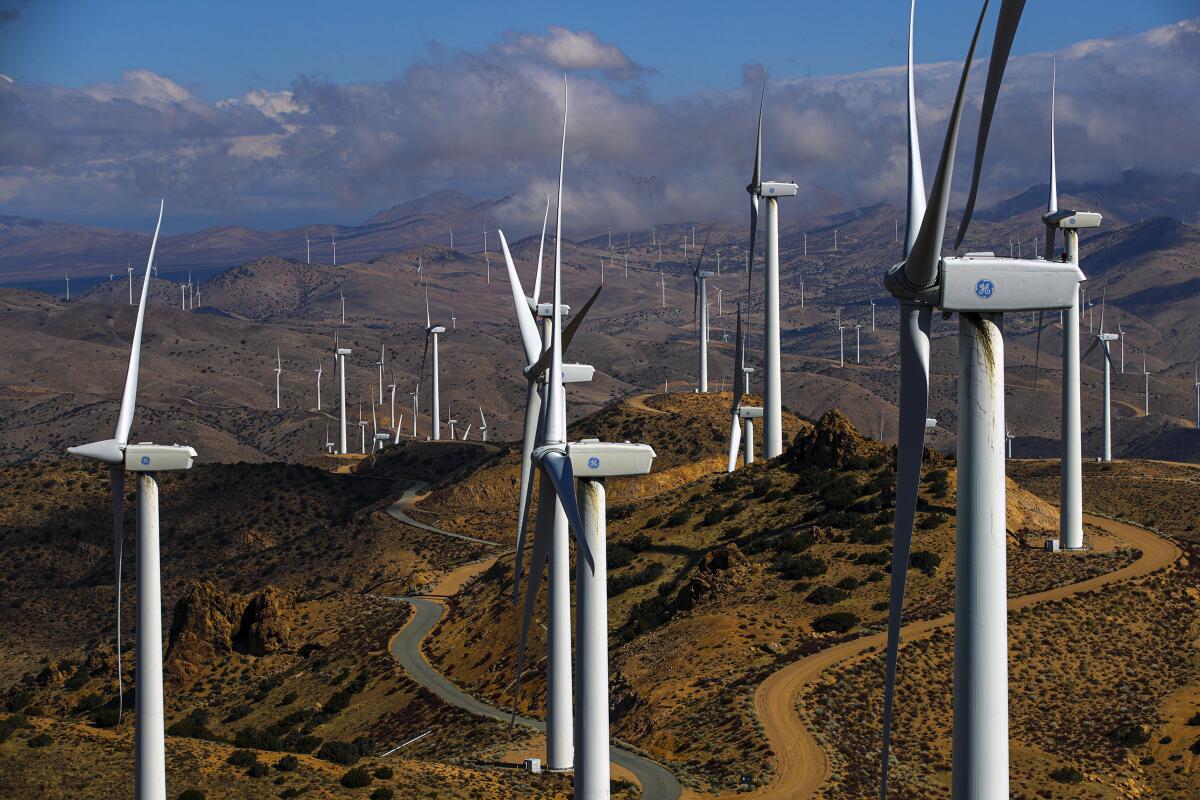Editorial: Yes, L.A. can keep the lights on with 100% green power

- Share via
Contrary to a fresh wave of skepticism about wind and solar power, Los Angeles can, in fact, power the city’s homes and businesses with 100% clean, renewable energy by 2035 without causing blackouts or breaking the bank.
That assurance is the result of three-year, in-depth analysis by a U.S. Department of Energy laboratory, and it should erase any doubt that Los Angeles and the rest of the country can wean the electricity sector off fossil fuels for the sake of the planet.
Questions about reliability and cost have hung over the efforts to green the nation’s electrical grid. Proponents of fossil fuels have seized on those unknowns to demonize renewable energy. When Texas was plunged into power outages last month during a cold snap, some conservative lawmakers there and in the nation’s capital wrongly tried to blame frozen wind turbines for the blackouts.
That’s why the study from the National Renewable Energy Laboratory is so important. Researchers analyzed and offered several different scenarios by which DWP could reliably deliver 100% renewable electricity, even as demand for power increases with more extreme weather, a growing number of electrical vehicles and fully electrified buildings.
If the Los Angeles Department of Water and Power quickly moved to build more wind farms, large-scale solar installations and battery facilities while persuading more households in L.A. to use solar panels, electric appliances and electric cars, the utility could get off fossil fuels by 2035, the report found. That’s a decade earlier than the deadline set by Mayor Eric Garcetti and the City Council. The report also lays out slower-paced scenarios under which the city would reach 100% renewables by 2045.
The less ambitious scenarios would cost $57 billion to $69 billion, while the more ambitious one with the 2035 deadline would cost about $86 billion. Those costs, spread over time, would not have a meaningful impact on the city’s $1-trillion-plus economy, according to the analysis. But there would be considerable benefits for communities burdened by pollution from power plants and vehicles.
Los Angeles absolutely should aim for the more aggressive 2035 target. The race to slow global warming is on, and communities need to move as fast as possible to slash greenhouses gases.
Plus, past experience suggests that when leaders commit to phasing out fossil fuels in favor of renewable energy, the market responds. In 2002, when California enacted its first target for green power, the state was heavily dependent on coal- and natural gas-burning generators. Within a few years, more than enough solar, wind and hydroelectric power became available to meet the state’s initial goals. State lawmakers have since adopted more ambitious renewable-energy targets.
It’s important to recognize how quickly technology is evolving to meet the mandates. It was a leap of faith when Gov. Jerry Brown signed Senate Bill 100 in 2018 to commit the state to 100% renewable energy by 2045. Lawmakers knew they couldn’t hit California’s ambitious climate change goals without weaning the state completely off electricity produced from fossil fuels. But nobody could say exactly how it would be done. As the federal report makes clear, now there is a clear pathway to convert fully to renewable power.
That doesn’t mean it will be easy. The DWP is currently analyzing how the transition to 100% renewables would affect customers’ rates. Upgraded or new transmission lines will be essential to move electricity to meet demand, but such projects often get tied up in fights with NIMBY forces or environmentalists. There are political challenges, too — the union representing workers in DWP’s natural gas-fueled power plants has waged a public battle against Garcetti’s plan to phase out fossil fuels.
But this is also a moment of great opportunity. President Biden has said he wants the nation to hit 100% renewable energy by 2035. His administration is working on an infrastructure proposal that could include $2 trillion for climate and clean energy projects. If enacted, that would be a huge help for cities and utilities across the country that are trying to make the transition to renewables.
Today, much of daily life is dependent on burning fossil fuel, which creates the greenhouse gas emissions that are threatening the planet. If the world has any hope of limiting the damage of global warming, we must fundamentally alter how we create and consume energy. We now know it’s not only an achievable goal, but also a responsible investment that can deliver reliable power and environmental benefits well into the future. It’s time to act.
More to Read
A cure for the common opinion
Get thought-provoking perspectives with our weekly newsletter.
You may occasionally receive promotional content from the Los Angeles Times.










